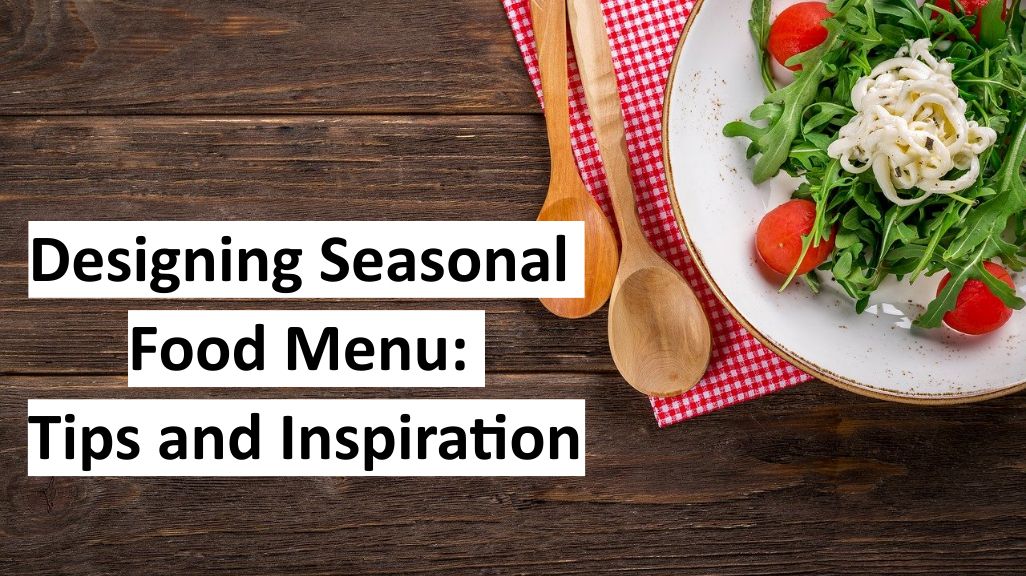In the dynamic realm of the culinary world, crafting a seasonal food menu is an art that requires a delicate balance of creativity, culinary expertise, and a keen understanding of your audience's preferences. A well-designed menu not only tantalizes taste buds but also reflects the spirit of the season. In this blog, we will explore the essential tips and inspiration for designing a seasonal food menu that leaves a lasting impression on your patrons.
Understanding the Essence of Seasonal Menus
Embracing Nature's Bounty
Creating a menu that changes with the seasons starts with embracing the abundance that nature offers during specific times of the year. Whether it's the vibrant colors of summer fruits or the hearty vegetables of fall, integrating fresh, in-season ingredients ensures a heightened culinary experience for your customers. Make a menu that mirrors the richness of each season, and let it guide your culinary creations.
Aligning with Local Harvests
Supporting local farmers and markets not only contributes to the community but also ensures the freshness and quality of your ingredients. Highlighting locally sourced produce establishes a connection with the region's flavors and fosters a sense of sustainability. This not only resonates with environmentally conscious diners but also enhances the authenticity of your seasonal offerings.
Crafting a Culinary Narrative
Telling a Seasonal Story
Consider your seasonal menu as a narrative that evolves with the changing weather. Create a story around your dishes, weaving together the inspiration behind each one. This not only adds an element of intrigue but also engages diners on a sensory and emotional level. For example, a winter menu could showcase hearty stews and roasts inspired by the need for warmth, while a summer menu might feature refreshing salads and grilled delights influenced by the desire for light, refreshing fare.
Balancing Familiarity and Innovation
While innovation is key, maintaining a balance between familiar favorites and experimental dishes is crucial. Offering a mix of both ensures that your menu caters to a diverse audience, appealing to those seeking comfort in tradition and those eager to explore new culinary horizons. For instance, a classic pumpkin pie might coexist with a pumpkin-spiced risotto, providing a blend of comfort and creativity for your diners.
Tips for an Effective Menu Design
Strategic Layout and Organization
A well-organized menu enhances the dining experience. Group similar items together, and strategically place high-profit items where diners are likely to focus their attention. Use clear headings, subheadings, and concise descriptions to guide customers through the menu effortlessly. A structured layout ensures that patrons can easily navigate through the offerings and find the seasonal delights they desire.
Seasonal Highlights
Make seasonal offerings stand out with enticing visuals and brief descriptions. Utilize keywords that evoke the essence of the season, such as "crisp," "harvest," or "refreshing." Consider incorporating symbols or icons to quickly denote seasonal specialties. Highlighting these items draws attention to the freshness and uniqueness of the seasonal produce, making it irresistible for customers.
Beverage Pairing Suggestions
Enhance the dining experience by providing beverage pairing suggestions for each seasonal dish. Whether it's a curated wine list, craft beers, or non-alcoholic options, thoughtful pairings can elevate the flavors and leave a memorable impression on your guests. This not only guides customers in choosing the perfect accompaniment but also showcases your commitment to providing a holistic dining experience.
Incorporating Trends and Innovations
Global Influences
Infuse global flavors into your seasonal menu to add a touch of diversity and excitement. Consider incorporating trending international ingredients or techniques that complement the seasonal theme. For example, a summer menu could feature a refreshing watermelon gazpacho inspired by Mediterranean influences, providing a unique twist to a seasonal classic.
Health-Conscious Offerings
As health-conscious dining continues to rise, include options that cater to different dietary preferences and restrictions. Whether it's plant-based, gluten-free, or low-carb, providing a variety of choices ensures that your menu appeals to a broader customer base. Highlight these options prominently to attract health-conscious diners and showcase your commitment to catering to diverse dietary needs.
Ensuring a Seamless Dining Experience
Staff Training and Knowledge
Equip your staff with in-depth knowledge about the seasonal menu. This not only enhances customer service but also allows your team to make informed recommendations, creating a more personalized and enjoyable dining experience. A well-informed staff contributes to the overall ambiance, making the dining experience memorable for patrons who appreciate the insights and guidance offered by knowledgeable servers.
Gathering Customer Feedback
Regularly seek feedback from your patrons about the seasonal offerings. This not only helps in refining your menu but also fosters a sense of customer engagement. Consider implementing seasonal specials based on popular demand and feedback. Customer feedback is invaluable in understanding preferences, ensuring that your seasonal menu evolves to meet the ever-changing tastes of your audience.
Conclusion
In the realm of culinary excellence, designing a seasonal food menu is an art that combines creativity, culinary expertise, and a deep understanding of seasonal ingredients. By embracing the essence of each season, crafting a compelling culinary narrative, and incorporating strategic design elements, you can create a menu that not only delights the taste buds but also leaves a lasting impression on your patrons.





Comments